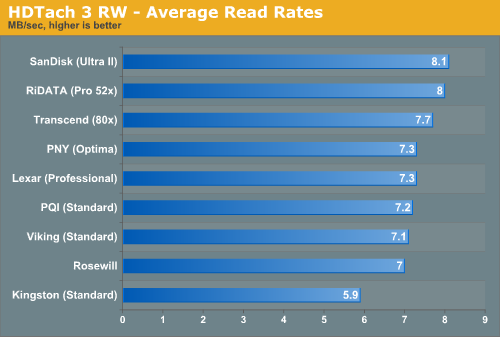Flash Media: 1GB CompactFlash Roundup
by Purav Sanghani on December 23, 2005 12:05 AM EST- Posted in
- Storage
HDTach 3 RW
HDTach 3 RW provides us with information regarding the average read and write rates for each media.
HDTach 3 RW provides us with information regarding the average read and write rates for each media.












24 Comments
View All Comments
mindless1 - Friday, December 23, 2005 - link
I agree about CF-IDE testing, and was hoping we'd see a listing of which cards do or don't support DMA. To the *embedded* systems crowd, that would be pretty significant.Hikari - Friday, December 23, 2005 - link
Don't most cameras (new ones that is) use SD cards? I'd love to see a review of them. I just bought a 150x Transcend card, but it was hard to find any real reviews anywhere.ProviaFan - Friday, December 23, 2005 - link
Point and shoot digicams do use SD or other small media predominantly. However, CompactFlash still reigns supreme in the digital SLR world; the small Nikon D50 and a similar Pentax are the only DSLRs that take SD exclusively, though there are a few others that can use an SD card as a backup along with a CompactFlash card.ProviaFan - Friday, December 23, 2005 - link
Point and shoot digicams do use SD or other small media predominantly. However, CompactFlash still reigns supreme in the digital SLR world; the small Nikon D50 and a similar Pentax are the only DSLRs that take SD exclusively, though there are a few others that can use an SD card as a backup along with a CompactFlash card.BikeDude - Friday, December 23, 2005 - link
First of all... Given any sub-2GB storage device for a camera, the choice is easy: FAT16 filesystem with the largest possible cluster size.Because most of the time, you'll be storing big picture files, the big cluster size won't waste nearly as much space as a big allocation table! (do the math, if you have 512 Byte clusters, you'll end up with a pretty big allocation table)
Secondly, write performance will vary depending on camera brand and model. http://robgalbraith.com/bins/multi_page.asp?cid=60...">http://robgalbraith.com/bins/multi_page.asp?cid=60... provides a more relevant yardstick. Keep in mind: You'll notice any delay much more while shooting pictures -- not while you transfer to your PC afterwards!
Thirdly, any file benchmark with random write behaviour is flawed in this test. When using a camera, all files will be stored sequentially. There's very little seeking taking place... Thus there's no need for a separate HDTach test. The file copy to media should suffice plenty. Only one of the tests will provide a relevant picture. (hard to tell if they provided the same numbers...? Different graph styles have been used!)
Finally, why leave the Sandisk Extreme III cards outside this test? They are the absolute best... (and have been for over a year!)
--
Rune
quanta - Friday, December 23, 2005 - link
Speaking of absolute best, Sandisk's record was just broken by Twinmos (140x) and ATP ProMax (150x). For that matter, CompactFlash record is already broken by MMC Plus cards, which goes up to 200x, with the announced 266x from Pretec.Cygni - Friday, December 23, 2005 - link
A sequential test would be nice, but i doubt it would change the results a whole lot. It would be good for us CF camera users, though. But AT is a computer site... not a Camera site. They tested using CF's using computer standards and techniques, for computer storage more or less.Also, AT only tests what they get sent. If Newegg didnt send them a Sandisk Ex III, they dont get to test one. They aint rollin in the dough.
I really liked the idea of CF roundup. Its something ive never seen AT do, and with motherboards so close in performance, new CPU's performance predictable, and video cards all based on reference designs, its good for AT to branch out into some new stuff for us to read.
PuravSanghani - Friday, December 23, 2005 - link
Well actually, we don't ONLY test what NewEgg or any other manufacturers/retailers send us. We specifically asked for these models for our first 1GB CompactFlash roundup...yes, first! So there is more to come in the flash media area.As for how we benchmark and why we do it the way we do on computers instead of using digital cameras, many who use flash media for more than just digital camera storage, like MP3 players and PDAs, use USB based card readers interfaced with their PCs. We benchmark this way to compare the performance of each card relative to the other products in the article.
As for all new areas we journey into we greatly appreciate any constructive criticism to improve our processes.
Thank you all and have a safe and happy holiday.
Purav
BikeDude - Sunday, December 25, 2005 - link
"use USB based card readers interfaced with their PCs."I hope you realise that performance varies greatly between most card readers. (e.g. few of them supports the latest PIO modes added to the CF specs a year ago)
I would've started by benchmarking the readers. My top candidates are Lexar's latest Firewire based reader, SanDisk latest USB2 reader, as well as Delkin's CardBus based reader.
I doubt a reader that can read multiple card formats performs well when compared with the ones I mentioned.
(Slightly related pet peeve: Laptop tests that give a laptop "+" for having a CF reader, but doesn't bother testing its speed -- My notebook's built-in reader is useless)
--
Rune
Anton74 - Friday, December 23, 2005 - link
FYI, I just noticed that the RiDATA CF cards available on newegg are all 80x - the 1GB model is $60 plus S&H.The tested RiDATA Pro-52x looked to me like the most attractive blend between performance and expected life expectancy. I'm guessing the 80x is faster and shorter lived. (But how short is short, really?)